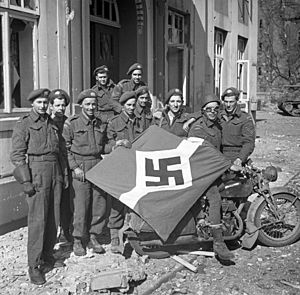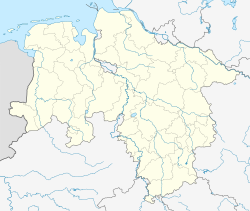Razing of Friesoythe facts for kids
Quick facts for kids Razing of Friesoythe |
|||||||
|---|---|---|---|---|---|---|---|
| Part of the Western Allied invasion of Germany in the Western Front of the European theatre of World War II | |||||||
 Canadian soldiers with a Hitler Youth flag at Friesoythe on 16 April 1945 |
|||||||
|
|||||||
| Belligerents | |||||||
| Commanders and leaders | |||||||
| Units involved | |||||||
| Part of 4th Canadian (Armoured) Division | Part of 7th German Parachute Division | ||||||
| Strength | |||||||
| Three battalions | 700 men | ||||||
| Casualties and losses | |||||||
| Unknown | Unknown | ||||||
| 20 German civilians killed | |||||||
|
Friesoythe
|
|
|---|---|
The destruction of Friesoythe happened on April 14, 1945. This was during the Western Allied invasion of Germany near the end of World War II. The town of Friesoythe in Lower Saxony, Germany, was almost completely destroyed. Canadian soldiers from the 4th Canadian (Armoured) Division attacked the town. One of their groups, called The Argyll and Sutherland Highlanders of Canada, captured it.
Contents
What Happened in Friesoythe?
During the fight, the Canadian commander of the Argyll and Sutherland Highlanders of Canada, Fred Wigle, was killed. A German soldier killed him. However, a false rumor spread that a civilian had killed him.
The Order to Destroy the Town
Because of this mistaken belief, the Canadian division's leader, Major-General Christopher Vokes, gave a harsh order. He commanded his troops to destroy the town as a form of revenge. As a result, Friesoythe was largely ruined.
Impact on Civilians
During the two days of fighting and its aftermath, about 20 German civilians died. This happened in Friesoythe and the areas nearby. Similar events, though usually less severe, also took place in other German towns. This occurred as the Allied forces moved forward in the last weeks of the war.
After the Destruction
The destroyed buildings of Friesoythe were not just left as rubble. The Canadian soldiers used the broken pieces of the town. They filled large holes in the local roads with this rubble. This made it possible for their tanks and heavy vehicles to pass through.
Other Towns Affected
A few days before Friesoythe, the same Canadian division had also destroyed the center of another town called Sögel. This was also done as a form of punishment. The rubble from Sögel was also used to fix roads.
How the Event Was Remembered
Not much was officially said about the destruction of Friesoythe. The official history of the Canadian Army in World War II does not focus on it much. However, the stories of the military units involved do mention it. Many books about the war campaign also talk about it. Forty years later, Major-General Vokes wrote in his own book that he felt "no great remorse" about what happened to Friesoythe.


